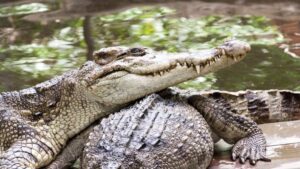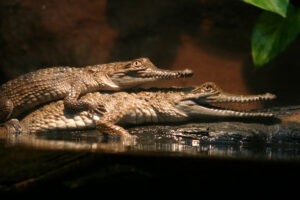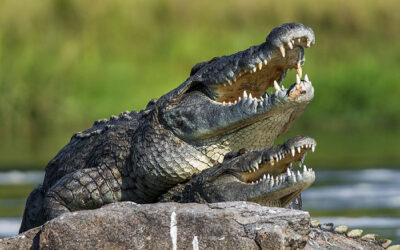Ever wondered if alligators and crocodiles, those impressive reptiles that roam our planet, could actually get together and make little crocogators or alligodiles? Well, it turns out, people have been scratching their heads over this question too – can alligators and crocodiles mate?
No, alligators and crocodiles cannot mate and produce hybrid offspring. Despite sharing similarities and belonging to the same order, Crocodylia, they are distinct species with enough genetic differences to prevent successful interbreeding.
The reproductive barriers between alligators and crocodiles are significant, and their evolutionary paths have led to distinct physiological and behavioral differences. While they may occupy similar ecological niches, the genetic incompatibility prevents the formation of hybrids between the two.
Can alligators and crocodiles mate?

No, alligators and crocodiles generally do not mate in the wild due to being different species within the order Crocodylia. While they share similarities, such as their overall body shape and lifestyle, they have distinct differences in terms of anatomy and behavior. These differences extend to their reproductive systems, making it unlikely for successful mating to occur.
The genitalia of male alligators and crocodiles have specific characteristics unique to each species, preventing effective copulation between them. Additionally, these reptiles have evolved to occupy different ecological niches, and in the wild, they are more likely to compete for resources and territory rather than engage in cross-species mating.
While there have been rare instances of hybridization, known as “crocogators” or “gatorciles,” these occurrences are typically observed in captivity under artificial conditions where different species may be kept together. In natural settings, however, these reptiles are more likely to mate within their own species, maintaining the genetic integrity of each.
Key Differences Between Alligators and Crocodiles
Alligators and crocodiles belong to the order Crocodylia and share several similarities due to their common ancestry, but they also have distinct differences in terms of physical characteristics, behavior, and habitat preferences. Here are some key differences between alligators and crocodiles:
- Snout Shape:
- Alligators: Alligators have a broad and U-shaped snout, which is well-suited for crushing prey.
- Crocodiles: Crocodiles, on the other hand, have a more V-shaped and elongated snout, adapted for grabbing and holding onto prey.
- Tooth Arrangement:
- Alligators: In alligators, the teeth on the upper jaw fit into sockets in the lower jaw, so only the upper teeth are visible when the mouth is closed.
- Crocodiles: In crocodiles, both upper and lower teeth are visible even when the mouth is closed, as the fourth tooth on the lower jaw fits into a notch in the upper jaw.
- Habitat:
- Alligators: Alligators are generally found in freshwater habitats, such as swamps, lakes, and rivers, but they can tolerate slightly brackish water.
- Crocodiles: Crocodiles are more versatile and can inhabit both freshwater and saltwater environments, including rivers, estuaries, and coastal areas.
- Geographical Distribution:
- Alligators: Alligators are native to the United States and China, with the American alligator found in the southeastern United States and the Chinese alligator found in eastern China.
- Crocodiles: Crocodiles have a more widespread distribution and can be found in various continents, including Africa, Asia, Australia, the Americas, and some islands.
- Behavior:
- Alligators: Alligators are generally considered less aggressive than crocodiles and are known for being more tolerant of sharing their habitat with other alligators.
- Crocodiles: Crocodiles are often regarded as more aggressive and territorial. They may show greater aggression towards members of their own species and other animals.
- Coloration:
- Alligators: Alligators usually have a darker coloration, ranging from black to dark olive brown.
- Crocodiles: Crocodiles often have a lighter coloration, with shades of tan, gray, and green.
- Temperature Tolerance:
- Alligators: Alligators are more tolerant of cooler temperatures and can endure colder climates compared to crocodiles.
- Crocodiles: Crocodiles are better adapted to warmer temperatures and are often found in tropical and subtropical regions.
Understanding these differences can help in distinguishing between alligators and crocodiles when observing them in the wild or in captivity.
Reproductive Anatomy of Alligators and Crocodiles

The reproductive anatomy of alligators and crocodiles shares similarities due to their common classification in the order Crocodylia. Both male and female reproductive systems play crucial roles in the reproduction of these reptiles. Here is an overview of the reproductive anatomy of alligators and crocodiles:
Male Reproductive Anatomy:
Testes:
- Both alligators and crocodiles have paired testes, which are responsible for producing sperm.
- The testes are located internally, near the kidneys, within the abdominal cavity.
Cloaca and Phallus:
- The cloaca is a common opening for the digestive, urinary, and reproductive systems in reptiles.
- In male alligators and crocodiles, a phallus extends from the cloaca during copulation. The phallus aids in the transfer of sperm to the female.
Female Reproductive Anatomy:
Ovaries:
- Alligators and crocodiles have paired ovaries, which produce eggs (ova).
- The ovaries are also located internally, typically in the abdominal cavity near the kidneys.
Oviducts:
- The oviducts are the structures where fertilization takes place after copulation.
- In females, the oviducts transport eggs from the ovaries to the cloaca.
Cloaca:
- As in males, the cloaca in females serves as a common opening for the digestive, urinary, and reproductive systems.
- During copulation, the cloacas of the male and female come into close contact, facilitating the transfer of sperm to the female’s reproductive tract.
Reproductive Process:
- Courtship and Copulation:
- Courtship behaviors vary among species but often involve vocalizations, displays, and physical interactions.
- Copulation occurs in water, with the male positioning himself on top of the female.
- Fertilization:
- Fertilization takes place internally within the female’s oviducts.
- The male transfers sperm to the female through the phallus, facilitating fertilization of the eggs.
- Egg Formation:
- Fertilized eggs move through the oviducts, where they receive protective layers.
- The eggs develop hard shells that provide protection during incubation.
- Nesting and Incubation:
- The female constructs a nest, often a mound of vegetation, where she lays the eggs.
- The eggs are left to incubate in the nest, and the heat from the environment determines the sex of the developing embryos.
- Hatching:
- After an incubation period, the eggs hatch, and the hatchlings emerge from the nest.
Understanding the reproductive anatomy and process of alligators and crocodiles contributes to our knowledge of their life cycle and helps in conservation efforts for these ancient reptiles.
Challenges and barriers to successful mating

Successful mating in alligators and crocodiles can face various challenges and barriers, both natural and human-induced.
Here are some factors that can affect the reproductive success of these reptiles:
- Habitat Loss and Fragmentation:
- Destruction and fragmentation of natural habitats due to human activities, such as urbanization, agriculture, and infrastructure development, can limit the available nesting sites and reduce suitable areas for courtship and mating.
- Climate Change:
- Changes in temperature and precipitation patterns can impact the nesting environment. Temperature plays a crucial role in determining the sex of hatchlings, and alterations in climate conditions may affect the sex ratio of offspring.
- Pollution:
- Pollution of water bodies, whether from industrial discharges, agricultural runoff, or other contaminants, can negatively affect the health of alligators and crocodiles. These pollutants can interfere with reproductive hormones and embryonic development.
- Invasive Species:
- The introduction of invasive species into ecosystems can disrupt the natural balance and lead to increased competition for resources, predation on eggs and hatchlings, and altered ecological dynamics, all of which can affect reproductive success.
- Human Disturbance:
- Human activities, such as boat traffic, tourism, and recreational activities, can disturb nesting sites and disrupt courtship behaviors. These disturbances may lead to abandonment of nests or reduce the likelihood of successful mating.
- Poaching and Illegal Trade:
- Alligators and crocodiles are often targeted for their hides, meat, and other body parts, leading to population declines. Poaching can interfere with population demographics and reduce the number of reproductive individuals.
- Disease:
- The spread of infectious diseases can impact the health of individuals and populations. In some cases, diseases may affect reproductive organs, hormonal balance, or the ability to care for eggs and hatchlings.
- Genetic Issues:
- Small and isolated populations may face genetic challenges, including inbreeding depression, which can reduce reproductive fitness and the overall health of the population.
- Predation:
- Eggs and hatchlings are vulnerable to predation by various animals, including birds, mammals, and other reptiles. Predation can significantly reduce the number of offspring reaching maturity.
- Altered Hydrology:
- Changes in water flow, including alterations to natural river systems and water management practices, can impact nesting habitats and the availability of suitable environments for reproduction.
Conservation efforts for alligators and crocodiles often involve addressing these challenges, including habitat protection, management of human activities, combating illegal trade, and implementing strategies to mitigate the impacts of climate change and pollution. Understanding and addressing these factors are crucial for the long-term survival and reproductive success of these ancient reptiles.
Conclusion
Can alligators and crocodiles mate? Although occasional in captivity, inherent species distinctions and ecological constraints make wild interbreeding extremely uncommon. These ancient reptiles generally prioritize mating within their respective species.

